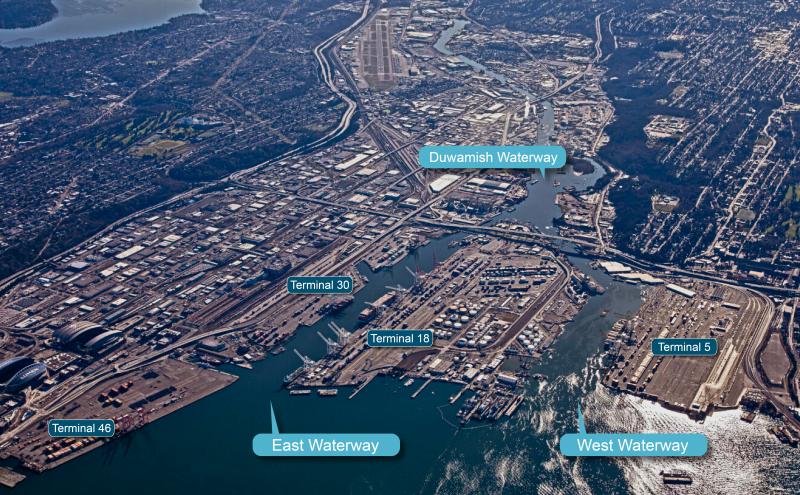
The largest container vessels calling at West Coast ports today have roughly twice the capacity of those that served our ports just a few years ago. In order to remain a competitive trade gateway for Northwest shippers and to preserve thousands jobs related to maritime trade, the Port of Seattle and Northwest Seaport Alliance are working with the U.S. Army Corps of Engineers (USACE) to deepen the navigation channels to -57 mean lower low water (MLLW) feet.
Project Timeline
In 2014, the Port of Seattle and USACE began work together on a Feasibility Study, evaluating the environmental and economic impacts of deepening the Seattle Harbor to -57 MLLW feet. That study was completed in 2017, and a year later the project was officially authorized by the U.S. Congress.
In 2023 the Port of Seattle signed the Design Agreement with the USACE and the Preconstruction, Engineering, and Design Phase began for the West Waterway. This project phase is expected to be completed in late 2026, at which time the Port of Seattle and USACE will negotiate a Project Partnership Agreement for construction. The construction phase for the West Waterway is expected to last two years and remove approximately 700,000 cubic yards of dredged material.
Ships are getting bigger
Today Port of Seattle regularly receives calls from ships with capacities up to 15,000 TEUs, whereas 5,000 to 6,000 TEUs was the norm just a few years ago. Major West Coast ports are deepening their navigation channels in order to serve these container ships, which have draft requirements deeper than 50’.
The economic case for deepening
The deepening initiative seeks to protect jobs and help preserve the infrastructure that allows our region’s farmers and manufacturers to connect to global markets. Insufficient channel depths require ocean carriers to take on less cargo or delay departures. These limitations hinder shippers’ ability to operate in the Puget Sound region, particularly for exports, which tend to be heavier than imports. The operational limitations can also have financial implications for ocean carriers.
The Northwest Seaport Alliance faces stiff competition from both U.S. East Coast and West Coast ports. Our region is also competing with the Canadian ports of Vancouver and Prince Rupert, which has no depth limitation. Thousands of jobs are at risk from cargo diversion to Canada alone, as are many other jobs with shippers who rely on our seaport.
The Port’s commitment to environmental protection
The Feasibility Study analyzed the environmental impact of various deepening alternatives. The Port of Seattle is dedicated to environmental stewardship and will ensure the deepening plan supports our commitment to protecting water quality and wildlife in Puget Sound. The Feasibility Study and Environmental Assessment found that by enabling bigger, more modern ships to call our gateway, our terminals can move additional cargo more efficiently but with 10% fewer vessel calls. This will reduce greenhouse gas and diesel emissions, as well as decrease underwater noise that impacts Southern Resident Killer Whales.
Learn more about the Seattle Harbor Navigation Improvement Project and view the final Feasibility Report on the U.S. Army Corps of Engineers’ website.


